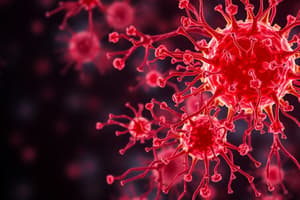Podcast
Questions and Answers
What is the role of pattern recognition receptors (PRRs) in the innate immune response?
What is the role of pattern recognition receptors (PRRs) in the innate immune response?
- Produce antibodies against a wide variety of pathogens
- Trigger adaptive immune responses against specific pathogens
- Recognize characteristic features of pathogens and molecules released by damaged cells (correct)
- Regulate the activity of cytotoxic NK cells
Why is the variety of pattern recognition receptors limited in the innate immune system?
Why is the variety of pattern recognition receptors limited in the innate immune system?
- To increase the number of receptors active against pathogens
- Due to the need for each receptor type to be encoded by a specific gene (correct)
- To focus on recognizing only a particular type of pathogen
- Because they are not present on the cell surface
What is the major difference between the innate and adaptive immune systems in terms of receptor diversity?
What is the major difference between the innate and adaptive immune systems in terms of receptor diversity?
- Innate and adaptive immune systems have an equal number of diverse receptors.
- Innate immune system has no receptors, while adaptive immune system has many receptors.
- Innate immune system uses a limited number of receptors with broad specificity, while adaptive immune system uses numerous specific receptors. (correct)
- Innate immune system uses specific receptors for each pathogen, while adaptive immune system uses broad-spectrum receptors.
Why is the variety of pattern recognition receptors in the innate immune system constrained by the cell membrane's surface area?
Why is the variety of pattern recognition receptors in the innate immune system constrained by the cell membrane's surface area?
Which type of immune response has evolved prior to the other, innate or adaptive?
Which type of immune response has evolved prior to the other, innate or adaptive?
What is the main disadvantage of the approach used by the innate immune system in terms of receptor specificity?
What is the main disadvantage of the approach used by the innate immune system in terms of receptor specificity?
What is the primary function of the innate immune system cells upon recognizing a pathogen?
What is the primary function of the innate immune system cells upon recognizing a pathogen?
What is the role of chemokines in the immune response?
What is the role of chemokines in the immune response?
What distinguishes chemokines from cytokines?
What distinguishes chemokines from cytokines?
Which type of signaling molecule allows cells to communicate with each other over short distances?
Which type of signaling molecule allows cells to communicate with each other over short distances?
What initiates a change in the physiology of a receiving cell when exposed to a cytokine?
What initiates a change in the physiology of a receiving cell when exposed to a cytokine?
Which event occurs when an innate immune system cell recognizes an intracellular pathogen?
Which event occurs when an innate immune system cell recognizes an intracellular pathogen?
What is the main function of the cells of the innate immune system upon recognizing a pathogen?
What is the main function of the cells of the innate immune system upon recognizing a pathogen?
How do cytokines and chemokines differ in their functions?
How do cytokines and chemokines differ in their functions?
What type of receptor is usually found on cells of the innate immune system?
What type of receptor is usually found on cells of the innate immune system?
What is the primary function of chemokines in the immune response?
What is the primary function of chemokines in the immune response?
How do soluble mediators affect the behavior of cells in the immune response?
How do soluble mediators affect the behavior of cells in the immune response?
What happens when an intracellular pathogen is recognized by a cell of the innate immune system?
What happens when an intracellular pathogen is recognized by a cell of the innate immune system?
What type of cells recognize patterns of pathogen-specific molecules in the innate immune response?
What type of cells recognize patterns of pathogen-specific molecules in the innate immune response?
Why is the variety of pattern recognition receptors limited in the innate immune system according to the text?
Why is the variety of pattern recognition receptors limited in the innate immune system according to the text?
How does the approach to receptor diversity differ between the innate and adaptive immune systems?
How does the approach to receptor diversity differ between the innate and adaptive immune systems?
What is the primary constraint on the variety of pattern recognition receptors in the innate immune system?
What is the primary constraint on the variety of pattern recognition receptors in the innate immune system?
What distinguishes pattern recognition receptors (PRRs) in the innate immune response from receptors in the adaptive immune response?
What distinguishes pattern recognition receptors (PRRs) in the innate immune response from receptors in the adaptive immune response?
Why does the innate immune system need to use a limited number of receptors that are active against a wide variety of pathogens?
Why does the innate immune system need to use a limited number of receptors that are active against a wide variety of pathogens?




